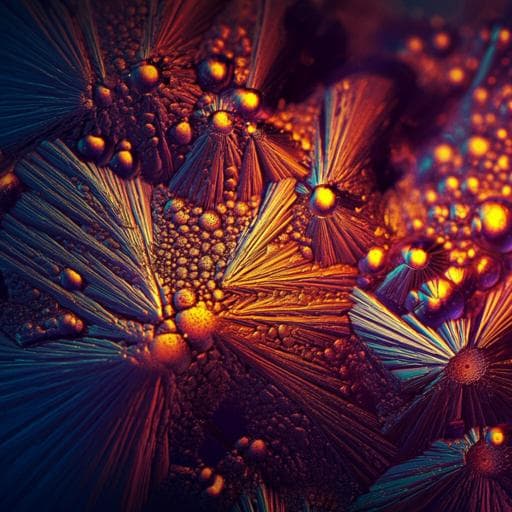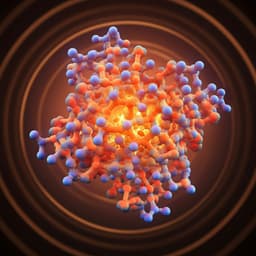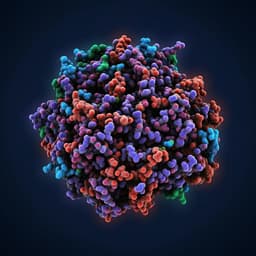
Chemistry
Observation of crystallisation dynamics by crystal-structure-sensitive room-temperature phosphorescence from Au(I) complexes
Y. Kuroda, M. Tamaru, et al.
This groundbreaking study delves into the fascinating world of room-temperature phosphorescence (RTP) in trinuclear Au(I) complexes. Conducted by a team of researchers from Ritsumeikan University, the findings reveal the intricate relationship between crystal structure and phosphorescence, with implications for new material properties at the nanoscale.
~3 min • Beginner • English
Introduction
The study addresses how crystallisation dynamics and polymorphism in organic/organometallic systems can be visualised in situ using luminescence, overcoming limitations of conventional techniques (electron microscopy, IR, Raman) that struggle to capture early-stage events. Most organic luminophores suffer aggregation-caused quenching, but aggregation-induced emission (AIE) materials enable enhanced emission upon aggregation. Certain Au(I) complexes exhibit AIE due to aurophilic interactions (non-covalent Au–Au bonding), suggesting that introducing multiple aurophilic interactions could yield strong aggregate-based RTP sensitive to aggregate/crystal structure. The authors hypothesise that slight variations in alkyl side-chain length will modulate crystal packing and intermolecular interactions, shifting RTP colour and enabling direct observation of crystallisation and polymorphic transitions via luminescence.
Literature Review
Prior work has shown size-dependent properties in organic nanocrystals and the challenges of observing crystallisation processes directly in situ. Conventional spectroscopies and imaging offer limited temporal or mechanistic resolution in early nucleation. AIE has emerged to counter aggregation-caused quenching, with many AIEgens non-emissive in dilute solutions but bright in condensed phases. Au(I) complexes can display AIE due to aurophilic interactions; trinuclear Au complexes have exhibited polymorphism, liquid-crystalline behaviour, and rich phosphorescence with bands near ~350, ~650, and ~750 nm attributed to monomeric triplet and excimeric triplet states. Previous computational and spectroscopic studies have implicated ligand-to-metal–metal charge transfer (LMMCT) in such systems. These foundations motivate using crystal-structure-sensitive RTP of trinuclear Au(I) complexes to probe crystallisation dynamics and polymorphic transitions.
Methodology
- Synthesis: Three trinuclear Au(I) pyrazolate complexes (DT4–DT6) bearing n-alkyl side chains of slightly different lengths were synthesised following literature procedures, purified by silica gel chromatography, and recrystallised from CH2Cl2/acetone to obtain bulk crystals.
- Bulk photophysics: Crystals (>100 µm) were placed between quartz plates. UV–vis absorption (JASCO V-550), steady-state photoluminescence (Hitachi F-7500), absolute photoluminescence quantum yields (Hamamatsu Quantaurus-QY C11347-01), and lifetimes at 280 nm excitation (Hamamatsu Quantaurus-Tau C1136-21) were measured at room temperature (15 °C) in air. Excitation and emission spectra were collected; lifetimes were measured at specific wavelengths per band.
- AIE assessment: Emission of dilute solutions (<1e-4 mol L−1) and mixed good/poor solvent systems (CH2Cl2/methanol) was examined to confirm aggregation-induced emission behaviour.
- Structural analysis: Single-crystal X-ray diffraction was performed; key parameters (space groups, intermolecular distances/angles) identified Au–Au and Au–π interactions forming dimers within supramolecular polymers. Powder XRD compared nanocrystals/microcrystals with bulk (experimental patterns vs simulated from single-crystal structures) to identify polymorphs.
- Computation: TD-DFT calculations (dimers extracted from crystal structures) evaluated molecular orbitals, S0→S1 transitions (oscillator strengths), and S0→T1 excitation energies to assign transitions (LMMCT vs others) and rationalise RTP colour sensitivity to intermolecular interactions.
- Nanocrystal preparation: Reprecipitation by injecting THF solutions (5.0 mmol L−1, 50 µL) into vigorously stirred deionised water (10 mL) produced stable nanocrystal suspensions (DLS mean diameters ~100 nm). Alternatively, CHCl3/methanol reprecipitation yielded initial microcrystals (~1–2 µm) that grew via Ostwald ripening to 50–100 µm over 24 h.
- Size characterisation: Dynamic light scattering (DLS-8000) quantified nano/microcrystal size distributions; polarized optical microscopy assessed crystals >10 µm.
- Monitoring crystallisation: Time-resolved RTP spectra were recorded during growth (e.g., DT4 in methanol after CHCl3/methanol reprecipitation) to follow polymorphic transitions via colour/spectral shifts.
- Mechanical pulverisation: Bulk crystals were ball-milled (PULVERISETTE 7; 20 mg crystals with methanol/water 2/5 v/v, zirconia balls, 320 rpm, 48 h). Size fractionation was achieved by sequential filtration (8 µm then 0.8 µm). RTP spectra of filtrates and residues were compared to assess size-dependent polymorphism independent of solvent effects.
- Data deposition: Single-crystal structures deposited at CCDC (DT4: 1973710; DT5: 1973709; DT6: 1910566).
Key Findings
- Aggregation-induced RTP: DT4–DT6 crystals show bright room-temperature phosphorescence in air, while dilute solutions are non-emissive, confirming AIE behaviour.
- High efficiencies and microsecond lifetimes: Total RTP quantum yields in bulk crystals reach 13–75% with microsecond lifetimes, e.g., DT6 bulk λmax ~738 nm, Φ ~75%, τ ~12 µs. DT6 nanocrystals: λmax ~727 nm, Φ ~69%, τ ~15 µs.
- Crystal-structure sensitivity: Small changes in alkyl side-chain length dramatically alter RTP colour in bulk: DT4 (yellow), DT5 (purple), DT6 (red), despite similar luminescent centres (Au and pyrazolyl π systems). Single-crystal analysis reveals distinct supramolecular dimers: DT4 features one intermolecular Au–Au interaction; DT5 has two Au–π interactions without intermolecular Au–Au; DT6 exhibits both Au–Au and Au–π interactions at two sites each.
- Computational assignments: TD-DFT on crystal dimers indicates S0→S1 transitions shift to 254–262 nm (vs 244 nm monomer), consistent with dimer formation. Allowed transitions suggest LMMCT is dominant for DT4 and DT6 dimers; DT5 involves n→intramolecular aurophilic bonding transitions. A broad excitation band near 300 nm in crystals corresponds to direct spin-forbidden S0→T1 transitions, consistent with prior reports. Large Stokes shifts, especially for DT4 and DT6, imply significant excited-state distortion.
- Size-dependent polymorphism and RTP: Nanocrystals (~100 nm) of all three complexes emit similar red RTP (λmax ~727–738 nm), unlike size-independent DT6 bulk vs nano but distinct from DT4/DT5 bulk colours. Powder XRD shows DT4 and DT5 adopt different crystal structures in nano- vs bulk forms, while DT6 retains the same structure across sizes.
- In situ observation of phase transitions: During growth from ~1–2 µm microcrystals to 50–100 µm, DT4 and DT5 RTP spectra evolve from red (nanocrystal-like) to their bulk-specific colours, evidencing metastable-to-stable polymorphic transitions. DT6 shows no spectral change upon growth.
- Pulverisation confirms size effect: Ball-milled size fractions reproduce size-dependent RTP: filtrates enriched in ~132 nm crystals show predominant nanocrystal red band (~740 nm), while residues (>0.8–8 µm) retain bulk-like spectra, indicating a threshold size for transition near ~10 µm.
- Energetics: Dimer association energies (computed) are 20.8 kJ mol−1 (DT4), 19.1 (DT5), 34.5 (DT6), rationalising the stability of DT6-like dimer motifs in metastable nano/microcrystals of DT4/DT5 and the delayed crossing point (>~10 µm) between metastable and stable polymorph free-energy curves.
Discussion
The findings validate the hypothesis that aggregate-based RTP of trinuclear Au(I) complexes is exquisitely sensitive to crystal packing and can serve as an optical reporter of crystallisation. In bulk, side-chain-controlled packing dictates distinct intermolecular interactions (Au–Au, Au–π) and corresponding emissive states, shifting RTP colour. In nano- and early microcrystalline regimes, DT4 and DT5 adopt a metastable polymorph featuring DT6-like dimer interactions, yielding uniform red RTP across all three complexes. Time-dependent RTP and XRD during crystal growth directly reveal a polymorphic transition from the metastable nano/microcrystal phase to the stable bulk phase, consistent with Ostwald’s step rule and a size-dependent free-energy landscape. The unusually large radius (~>10 µm) for the polymorph stability crossover is attributed to relatively large (more negative) bulk free energy arising from strong dimer association in the metastable phase, which also accelerates its nucleation. Pulverisation experiments decouple solvent effects, confirming that crystal size, not mechanical stress, governs the observed colour and structural changes. Overall, RTP colour becomes a sensitive, real-time probe of nucleation, growth, and phase transitions, offering mechanistic insight into early-stage crystallisation processes and the role of polymorphism in determining optoelectronic properties.
Conclusion
Trinuclear Au(I) complexes (DT4–DT6) exhibit efficient aggregation-induced RTP in crystals, with emission colour governed by crystal packing and intermolecular aurophilic and Au–π interactions. Minor changes in alkyl side-chain length alter bulk crystal structures and RTP colours. Critically, DT4 and DT5 display size-dependent polymorphism: nanocrystals and early microcrystals adopt a metastable polymorph with DT6-like dimer interactions, producing uniform red RTP, then transform to bulk-stable polymorphs as crystals grow (>~10 µm). These RTP colour/spectral changes enable direct, in situ and real-time observation of crystallisation dynamics and polymorphic phase transitions. The results highlight that nano- to microscale solids can exhibit behaviours distinct from bulk, underscoring the need to consider size effects in device-relevant materials. Future work could generalise this RTP-based crystallisation probe to other metal complexes and organic AIE systems, map kinetics and energetics of polymorphic transitions across solvents and temperatures, and exploit size-tuned polymorphism for functional materials design.
Limitations
- Solvent effects on nucleation and growth can influence polymorph selection; although pulverisation experiments mitigate solvent contributions, a comprehensive solvent-dependent study remains beyond this work.
- The analysis focuses on three related Au(I) complexes; generalisability to broader chemotypes and non-Au systems requires validation.
- Structural assignments for nanocrystals rely on powder XRD comparisons rather than full single-crystal structures, limiting atomic-level detail of metastable phases.
- Photophysical measurements were performed under specific excitation conditions (e.g., 280 nm) and at RT in air; behaviour under different atmospheres, temperatures, and excitations may vary.
Related Publications
Explore these studies to deepen your understanding of the subject.







